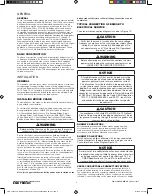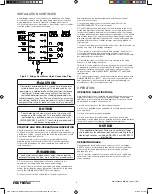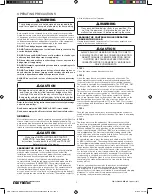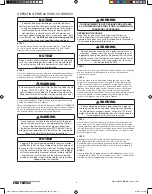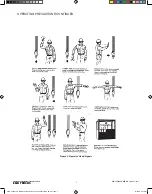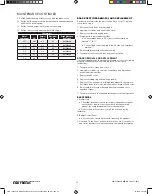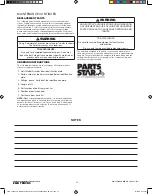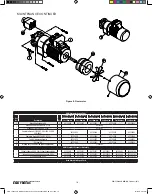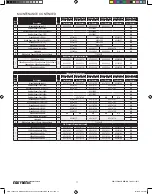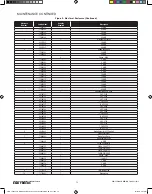
5
SINGLE & DOUBLE GIRDER TOP-RUNNING BRIDGES
WITH INDIVIDUAL MOTOR DRIVEN
END TRUCKS
P/N: 11532620 REV. AA
September 2018
OPERATING PRECAUTIONS
WARNING
These bridge cranes are not designed nor intended to be
used for support or transport of people or for transporting
loads over people.
Safe operation of an overhead hoist is the operator’s responsibility.
Listed below are some basic rules that can make an operator aware
of dangerous practices to avoid and precautions to take for his own
safety and the safety of others. Observance of these rules in addition
to frequent examinations and periodic inspection of the equipment
may save injury to personnel and damage to the equipment.
DO NOT load bridge beyond rated capacity.
DO NOT subject bridge crane to side loads. Always center trolley
over load when hoisting.
DO NOT stand and DO NOT cause or allow others to stand or get
under any load the bridge crane is supporting.
DO keep clear, and make sure others keep clear, of any load the
bridge crane is supporting.
DO NOT attempt to operate bridge crane before completing tests
and adjustments.
DO NOT run bridge crane into end stops, other bridge cranes, or
any obstruction on beam. Improper and careless operation can
result in a hazardous condition for operator and load.
ALWAYS be sure load is clear of obstruction before traversing
load.
CAUTION
If bridge crane is mounted on an open-end runway rail, then
end stops must be installed to prevent bridge crane from
running off the end of the runway rail resulting in injury to
the operator and others and damages to the load and other
property. End stops for the trolley must also be installed.
Refer to hoist and trolley instruction manuals for safety warnings
on hoists and trolleys.
Read and comply with ANSI B30.2 or B30.17-latest edition.
Read and comply with all local, state and national safety codes.
GENERAL
Motor driven cranes are usually operated from a pendant push button
station or radio control, which controls the bridge electrically. The
push button may be suspended from the bridge, trolley or hoist. Push
button control stations, supported by a strain cable, have a built-in
interlock to prevent energizing opposing motions at the same time.
CAUTION
Make sure all INSTALLATION AND START-UP
INSPECTION have been made in accordance with
instructions furnished with the HOIST and TROLLEY
before turning on the power.
LEARNING THE CONTROLS
After making certain the crane is completely and properly installed,
with the crane connected to the electrical service and all the
installation and start-up inspections made, the crane operator(s)
should learn and become acquainted with the controls.
On cranes having any or all motions electrically operated, the
operator should locate the runway disconnect and make sure this
switch is locked open (POWER OFF). The operator should now
operate the various push buttons to get the “feel” and determine
that they do not bind or stick in any position. The operator should
become familiar with push button location for their respective
motions as well as the “stop” buttons (normally the top red button),
which operate the crane main line contactor. The mainline contactor
will shut off power to all motions.
WARNING
If any push button binds or sticks in any position - Do
not turn the power on - Determine the cause of the
malfunction and correct it before operating the crane.
LEARNING THE CONTROLS WHILE OPERATING
CRANE WITH NO LOAD
Having inspected and tried the control, the crane operator is now
ready to try the crane under power.
CAUTION
ALWAYS ALLOW THE BRIDGE CRANE TO COME TO
A COMPLETE STOP BEFORE CHANGING DIRECTION.
ABRUPT CHANGE OF BRIDGE DIRECTION WHILE
IN MOTION MAY CAUSE ADVERSE OPERATING
CHARACTERISTICS OR DAMAGE TO BRIDGE AND
DRIVE COMPONENTS.
STEP 1.
Close the crane runway disconnect switch.
STEP 2.
Close the crane disconnect switch mounted on the crane. The
crane main disconnect switch is located in the bridge panel and
is operable from the front of the panel without opening the panel.
The switch is operated by rotating the handle. The “OFF” and “ON”
positions of the switch are marked on the switch assembly.
The bridge control panel also contains a 3-pole mainline contactor.
This contactor is connected in the electrical system on the load side
of the crane main disconnect switch, so that all the crane power
flows through this contactor. The mainline contactor is opened
and closed (turned off and on) by means of the stop button on the
pendant push button station. This stop circuit, as well as other
control circuits, typically operate at 115 volts. This 115 volt control
circuit voltage is obtained from a transformer mounted in the bridge
control panel.
STEP 3.
Turn the stop button clockwise to release the mainline contractor
which will apply power to all control devices. The crane is now ready
for use.
STEP 4.
The drive motors on the endtrucks of this crane are controlled
by inverters, programmable variable frequency control. Standard
programming on Yale•Shaw-Box provided controls is two step
infinitely variable. The motion buttons on the pushbutton for the
crane, typically labeled “FWD” and “REV” are two step buttons, for
this programming. The first step is the initial starting speed of the
crane and it also performs a speed hold function. The second step
of the button performs an acceleration function.
To operate the crane, press the button for desired direction, FWD
or REV, to the first step. The crane will start moving and accelerate
to its programmed starting speed. Press the same button further to
the second step and the crane will accelerate up to full speed. If the
crane reaches a desired speed during this acceleration, back the
button off to the first step to hold that speed. If the crane is traveling
too fast and you wish to slow it down, release the motion button
completely and the crane will start to decelerate. Once the desired
slower speed is obtained, press button to the first step to hold
that speed. To bring the crane to a stop release the motion button
completely, the crane will decelerate to a stop and the holding
brakes will set.
Practice operating the crane in both directions, accelerating to
intermediate and full speeds, decelerating to a slower speed,
and bringing it to a stop. Get acquainted with the operating
characteristics of this crane, acceleration, deceleration and stopping
distances, to ensure smooth load movement, accurate load
positioning, and to minimize load swing.
CMK_12322 Yale Rotating Axle End Truck Parts 11532619-REV AD_mec.indd 5
10/16/18 2:07 PM




